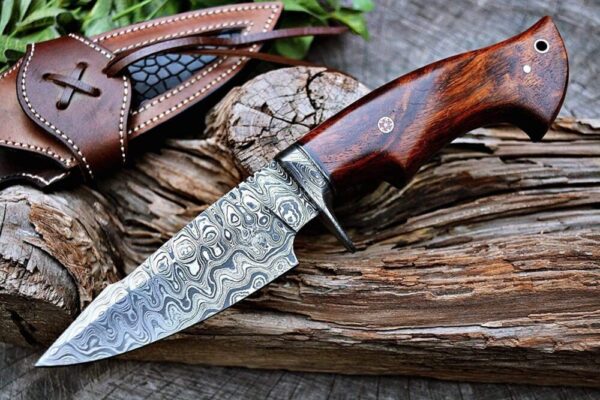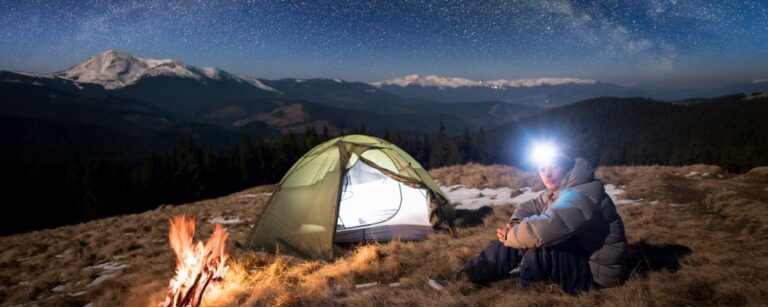The sun’s barely peeking over the horizon when you hear it – the unmistakable sound of hooves crunching through fallen leaves. Your heart races as a massive buck steps into view. But then, disaster strikes. A slight movement, a flash of color, and those alert eyes lock onto your position. In a blink, your trophy buck vanishes into the underbrush. If only you’d had better deer hunting blinds.
Hey there, fellow deer hunters! Whether you’re a seasoned pro or just starting, we all know that staying hidden is the name of the game. And when it comes to concealment, nothing beats a good hunting blind.
It’s like your personal fortress in the woods, keeping you hidden, comfortable, and ready for that perfect shot. Blind hunting is essential for staying hidden and comfortable, ensuring you remain undetected by those sharp-eyed deer.
But here’s the thing: not all hunting blinds are created equal. Pick the wrong one, and you might as well be waving a flag at those keen-eyed deer. That’s why we’ve put together this guide to help you find the best deer hunting blind for your needs.
In this post, we’ll walk you through everything you need to know about choosing the perfect hunting blind. We’ll cover the different types of blinds, what features to look for, and even throw in some setup tips from experienced hunters.
When you’re done reading, you’ll be ready to pick a blind to help you vanish into your surroundings like a woodland ninja.
So, grab your favorite camo hat, settle in, and let’s dive into the world of deer hunting blinds. Trust us, your future self – the one with the impressive buck – will thank you!
Benefits of a Homemade Hunting Blind
Building a homemade hunting blind can be a cost-effective and rewarding experience for hunters. One of the primary benefits of a homemade hunting blind is the ability to customize it to your specific needs and preferences.
You can choose the materials, design, and features best suit your hunting style and environment. Additionally, a homemade hunting blind can be a fun and challenging DIY project that allows you to express your creativity and skills.
Another benefit of a homemade hunting blind is the potential for increased stealth and concealment. Using raw materials and blending the blend into its surroundings, you can create a highly effective hide that lets you get up close and personal with your prey.
Furthermore, a homemade hunting blind can be a great way to spend quality time with family and friends, teaching them about hunting and the outdoors.
Types of Deer Hunting Blinds
Alright, hunters, let’s break down the different types of deer blinds you might encounter in the field. Each has its own pros and cons, catering to various hunting needs. From budget-friendly options to premium deer blinds with advanced features and luxurious amenities, there’s something for every hunter.
Pay attention – your perfect hide might be just a few paragraphs away!
Ground Blinds
Think of these as your portable hunting forts. They’re typically made of fabric stretched over a frame, creating a tent-like structure.
Pros:
They’re easy to move and set up
You can use them almost anywhere
They offer 360-degree concealment
Cons:
They can be a bit cramped
Some animals might be wary of a new “structure” in their territory
Elevated Blinds / Tree Stands
These deer stands get you off the ground, giving you a bird’s-eye view of your hunting area. There are several types, including climbing, ladder, and hang-on stands.
Pros:
Better visibility over a wider area
Your scent is carried above many animals
They can be very effective in the right location
Cons:
Safety is a big concern (always wear a harness!)
They can be heavy to carry in
You’re a bit more exposed to the elements
Box Blinds
These are like the luxury condos of the hunting blind world. They’re more permanent structures, usually made of wood or plastic.
Pros:
They’re roomy and comfortable
You can easily hunt with a buddy
They offer excellent protection from weather
Cons:
They’re not portable
They can be expensive
You need permission to build on the land
Natural Blinds
Sometimes, the best blind is the one Mother Nature provides. This could be a thick stand of trees, a brush pile, or even a depression in the ground.
Pros:
They’re free!
Animals are used to seeing them
They can be very effective when used correctly
Cons:
You’re more exposed to the elements
They might not be in the ideal location
You’ll need to be extra still and quiet
Remember, the “best” type of blind depends on where you’re hunting, what you’re hunting with, and your preferences. Many seasoned hunters use different types of blinds depending on the situation.
Factors to Consider When Choosing a Hunting Blind
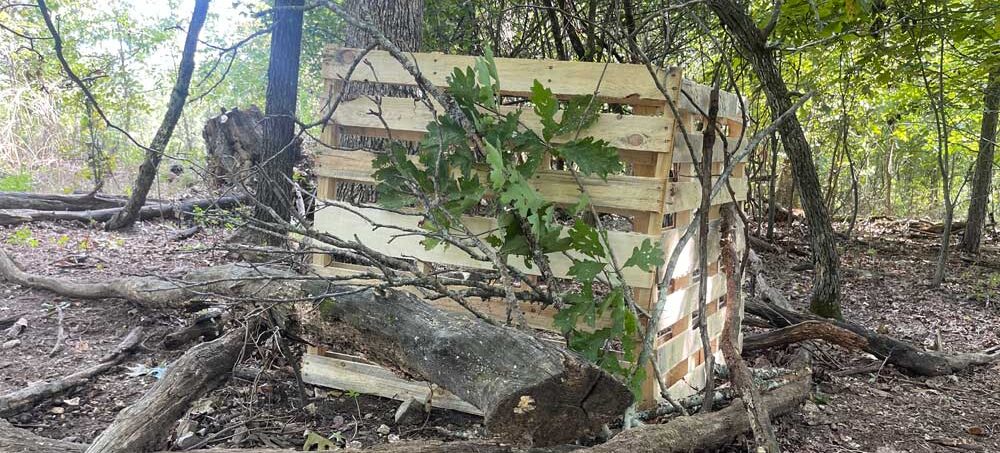
Okay, hunters, now that we know the types of blinds out there, let’s talk about how to choose the right one for you. It’s not just about picking the fanciest or most expensive option – it’s about finding the blind that fits your hunting style like a well-worn pair of boots. Choosing the right hunting blind is crucial for a successful hunt, whether using a bow or a gun. Using an incorrectly selected blind can lead to challenges and potential dangers during hunting.
Location and Terrain
Think about where you’ll be hunting. Are you in thick woods or open fields? Is the ground flat or hilly?
For open areas, a pop-up ground blind might be your best bet.
A tree stand could give you the height advantage in the woods.
If you’re dealing with swampy ground, an elevated box blind keeps you high and dry.
Hunting Style (Bow vs. Rifle)
Your weapon of choice plays a big role in blind selection.
Bow hunters need more drawing room, so look for blinds with tall ceilings and wide windows.
Rifle hunters can get away with smaller blinds, but ensure you have a stable rest for your firearm.
Comfort and Space
Let’s face it – hunting often means long hours of sitting still. Comfort matters!
If you’re planning all-day sits, a roomy blind with space to stretch is crucial.
Consider blinds with built-in chair systems for back support.
Look for blinds with enough space for a small heater for cold weather hunts.
Concealment and Camouflage
You want to stay hidden and blend in, not stick out like a sore thumb.
Look for blinds with camo patterns that match your hunting environment.
Consider blinds with built-in brush holders to add natural cover.
Black interior helps keep you hidden in the shadows.
Portability vs. Permanence
Are you a run-and-gun hunter, or do you have a favorite spot you return to year after year?
If you like to move around, a lightweight pop-up blind is your friend.
For a fixed location, a sturdy box blind or permanent tree stand might be worth the investment.
Weather Protection
Mother Nature doesn’t always play nice, so be prepared.
Look for waterproof materials if you hunt in rainy areas.
In windy regions, choose blinds with sturdy construction and good stake-down systems.
For cold climates, insulated blinds can be a game-changer.
Remember, there’s no one-size-fits-all solution. The best blind for you depends on your specific hunting situation. Don’t be afraid to mix and match – many hunters use blinds in their arsenal to cover all bases.
Building Your Homemade Hunting Blind
Building a homemade hunting blind requires planning, creativity, and elbow grease. Here are some general steps to follow:
Choose a location: Select a spot with good cover and concealment, and consider factors like wind direction, sunlight, and accessibility.
Design your blind: Sketch a basic design, considering the size, shape, and features you want. Think about the hunting you’ll be doing, the terrain and the weather conditions.
Gather materials: Collect the necessary materials, such as wood, fabric, netting, and other supplies. Consider using natural materials like branches, leaves, and grasses to blend in with the surroundings.
Build the frame: Construct the frame of your blind using wood or other sturdy materials. Make sure it’s sturdy and can withstand wind and weather.
Add windows and doors: Create windows and doors that allow you to see and shoot comfortably. Consider using see-through mesh or tinted windows for added concealment.
Building the Frame of Your Deer Blind
The frame of your hunting blind is the foundation of the entire structure. It needs to be sturdy, durable, and able to withstand wind, rain, and other environmental factors. Here are some tips for building the frame:
Use sturdy materials like 2x4s or 2x6s for the frame.
Consider using a hub-and-spoke design for added stability.
Make sure the frame is level and secure, using anchors or stakes to hold it in place.
Use weather-resistant materials like cedar or treated wood to protect the frame from the elements.
Creating Windows and Doors for Your Blind
Windows and doors are critical components of a hunting blind, allowing you to see and shoot comfortably while remaining concealed. Here are some tips for creating windows and doors:
Use see-through mesh or tinted windows for added concealment.
Consider using a door size that’s large enough to accommodate you and your gear comfortably.
Use sound-deadening materials like foam or fabric to reduce noise and prevent spooking game.
Make sure the windows and doors are secure and can be easily opened and closed.
By following these tips and guidelines, you can build a homemade hunting blind that’s effective, comfortable, and fun to use. Happy hunting!
Top 5 Deer Hunting Blinds
1. Ameristep Care Taker Ground Blind
- Key features: Pop-up design for quick setup, spacious interior, multiple shooting windows, durable construction.
- Pros: Easy to set up and take down, comfortable, affordable.
- Cons: It may not be as durable as some other blinds.
- Price: $110
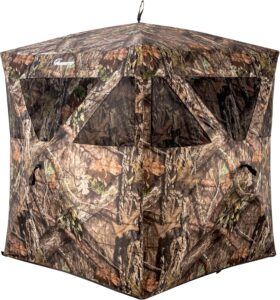
2. Primos Double Bull SurroundView Double Wide Ground Blind
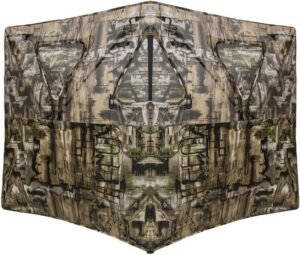
- Key features: Large, spacious interior, 360-degree visibility, durable construction, multiple shooting windows.
- Pros: Comfortable, easy to set up, great for hunting with a companion.
- Cons: Can be heavy and difficult to transport.
- Price: $100
3. Barronett Blinds Ox 5 5-Sided Hunting Blind
- Key features: Durable construction, 5-sided design for maximum concealment, multiple shooting windows, comfortable interior.
- Pros: Excellent concealment, sturdy, long-lasting.
- Cons: Can be expensive.
- Price: $360
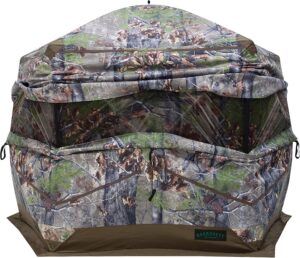
4. Rhino Blinds R150 Durable 3 Person Hunting Ground Blind
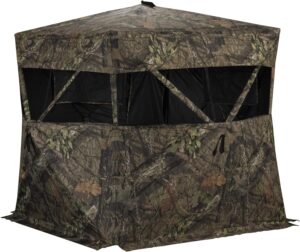
- Key features: Durable construction, spacious interior, multiple shooting windows, easy setup and takedown.
- Pros: Affordable, comfortable, suitable for various hunting conditions.
- Cons: May not be as durable as some other blinds.
- Price: $110
5. Hunting Blind 270/360 Degree See Through Ground Blind
- Key features: Durable construction, spacious interior, multiple shooting windows, easy setup and takedown.
- Pros: Affordable, comfortable, and suitable for various hunting conditions.
- Cons: It may not be as durable as some other blinds.
- Price: $120
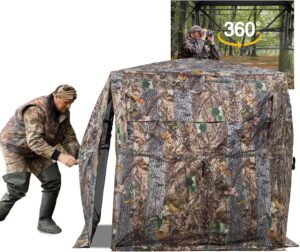
Setting Up Your Hunting Blind
Alright, hunters, you’ve got your blind picked out. Now, let’s talk about how to set it up for maximum effectiveness. Remember, a poorly placed or noisy blind is about as useful as a screen door on a submarine! Quick shipping times ensure that most orders ship the same or the next day, allowing hunters to set up their blinds promptly.
Choosing the Right Location
Scout, scout, scout: Don’t wait until hunting season to pick your spot. Get out there early and look for signs of deer activity.
Think like a deer: Consider food sources, water, and typical travel routes. Set up where these intersect.
Mind the wind: Position your blind downwind of where you expect deer to approach.
Use natural features: Set up near trees, bushes, or terrain features that break up your blind’s outline.
Consider the sun: Avoid locations where the sun will be in your eyes during prime hunting hours.
Tips for a Quiet and Efficient Setup
Practice at home: Set up your blind in the backyard a few times. You’ll be faster and quieter when it counts.
Arrive early: Give yourself plenty of time to set up without rushing. Rushed setups are noisy setups.
Wear gloves: They’ll keep your hands warm and reduce noise from touching metal parts.
Use stakes: Even if it’s not windy, stake down your blind. A shifting blind can ruin your hunt.
Brush it in: Use local vegetation to break up your blind’s outline. Many blinds have brush holders for this purpose.
Check your shooting lanes: Clear any obstructions that might interfere with your shot.
Set up your gear: Organize your calls, rangefinder, and other equipment so you can reach them silently.
Scent Control Considerations
Spray down: Use a scent-eliminating spray on your blind, inside and out.
Air it out: If your blind is new, set it up outside for a few days to off-gas.
Use the wind: Keep your scent blowing away from where you expect deer to approach.
Ground cloth: Use a scent-free ground cloth inside your blind to help control odors.
No smoking: Avoid smoking, eating strong-smelling foods, or using scented products in your blind.
Remember, setting up your blind isn’t a one-and-done deal. Be prepared to adjust based on deer movement patterns, changing winds, or other factors. The best hunters are always adapting!
Pro Tip: If you’re using a pop-up blind, consider setting it up a few weeks before you plan to hunt. This gives deer time to get used to it as part of the landscape. Just ensure you have permission if you’re on someone else’s land!
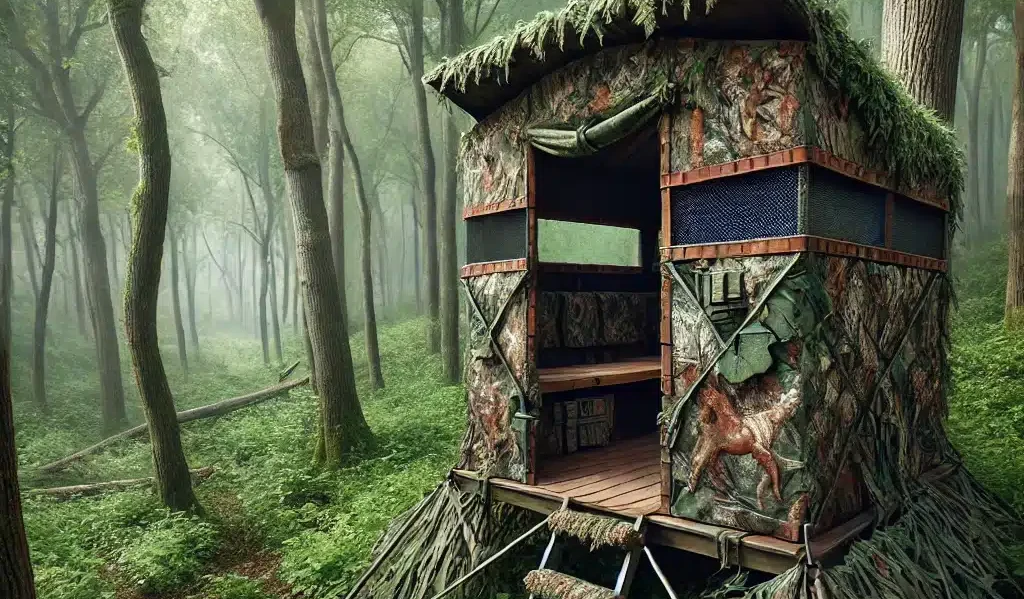
Maintaining and Storing Your Blind
Listen up, hunters! Your blind works hard for you in the woods, so it’s only fair to give it some TLC. Proper maintenance and storage keep your blind in fighting shape for many seasons. Let’s break it down:
Cleaning and Repairs
Post-hunt brush off: After each hunt, give your blind a good shake and brush off any dirt, leaves, or debris. This prevents build-up and keeps your camo pattern visible.
Deep clean: At the end of the season, thoroughly clean your blinds. For fabric blinds, use a soft brush and mild soap. For hard-sided blinds, a gentle cleaner and cloth will do the trick.
Check for damage: Inspect your blind for any tears, broken zippers, or loose parts. Small repairs now can prevent big problems later.
Waterproofing: If your blind is losing loses resistance, apply a waterproofing spray. Your future, dry self will thank you!
Lubricate moving parts: A little lubricant can keep things moving smoothly for blinds with mechanical parts (like pop-up mechanisms). Just be sure to use an odorless product.
Off-Season Storage Tips
Dry it out: Ensure your blind is completely dry before storing it. Moisture is the enemy here, as it can lead to mold and mildew.
Clean and odor-free: Store your blinds clean and scent-free. You don’t want to start next season with last year’s odors.
Cool and dry location: Find a spot that’s not too hot or humid. Avoid damp basements or super-hot attics.
Off the ground: If possible, hang your blind or store it on a shelf. This helps prevent moisture issues and keeps critters away.
Loose packing: Don’t store fabric blinds tightly compressed. This can damage the material and affect water resistance.
Rodent prevention: Consider storing your blind in a sealed plastic container. Mice love to make nests in stored hunting gear!
Avoid direct sunlight: Prolonged exposure to sunlight can fade camo patterns and degrade materials.
Pro Tips:
Keep a “blind repair kit” with patches, spare cords, and a sewing kit. You never know when you might need a quick fix in the field.
If you use scent wafers or cover scents in your blind, remove them before storage. They can attract pests.
For pop-up blinds, practice setting up and taking them down a few times before the season starts. It’ll knock off the rust and ensure everything’s working properly.
Remember, a well-maintained blind isn’t just about lasting longer – it’s about being more effective in the field. A blind that doesn’t smell doesn’t make noise, and blends in well is a blind that’ll help you bag that trophy buck.
Real Stories from Fellow Hunters
There’s nothing quite like learning from the experiences of other hunters. We’ve gathered some real-life stories that show just how important the right blind can be. Let’s dive in!
The Patient Bowhunter
Mike from Wisconsin shares: “I used to be all about run-and-gun hunting, but last season, I invested in a quality ground blind. Set it up two weeks before the season in a spot where several trails converged.
On opening day, I was settled in before dawn. Around 9 AM, a beautiful 10-pointer walked right up to my blind, completely relaxed. Thanks to the blind’s scent control and silent window system, I could draw my bow without detection. That buck is on my wall now, all because I learned the value of patience and a good blind.”
The Weather Warrior
Sarah from Oregon tells us: “Hunting in the Pacific Northwest, you’ve got to be ready for rain. Last November, we had a week of non-stop downpours. My new waterproof blind was a game-changer.
While other hunters were soaked and miserable, I stayed dry and comfortable. When most folks had given up on the third day, a nice 8-pointer stepped out. Being dry and ready made all the difference.”
The Elevated Advantage
Tom from Texas recounts: “I’d always been a ground blind guy, but decided to try an elevated box blind last season. What a difference! The extra height let me see over some brush that had always blocked my view.
One evening, I spotted a buck working a scrape line I never knew existed. The stable shooting rest in the blind helped me make a perfect 200-yard shot. I’m a convert now – you can’t beat that bird’s-eye view.”
The Family Tradition
Jake from Michigan shares: “I love taking my kids hunting, but keeping them quiet and still was always a challenge. Last year, we got a spacious hub-style blind. It was a game-changer!
The kids could whisper, snack, and even play quiet games on their tablets without spooking deer. My 12-year-old daughter got her first deer—a nice doe—from that blind. Seeing her excitement made every penny worth it.”
The DIY Success
Lisa from Kentucky tells us: “I’m on a tight budget, so I decided to build my blind using natural materials. I spent a weekend weaving branches and grass into a simple structure. It wasn’t fancy, but it blended in perfectly.
A week later, I saw two dogs walking within 10 yards, unaware of my presence. This is proof that sometimes the best blind is the one that matches your environment perfectly!”
These stories show that the right blind can make a real difference in your hunting success. Whether staying comfortable in bad weather, getting a better vantage point, introducing kids to hunting, or just doing perfectly with your surroundings, the right blind can be a game-changer.
Remember, every hunter’s needs are different. What works for one might not work for another. The key is finding what suits your hunting style and your conditions.


